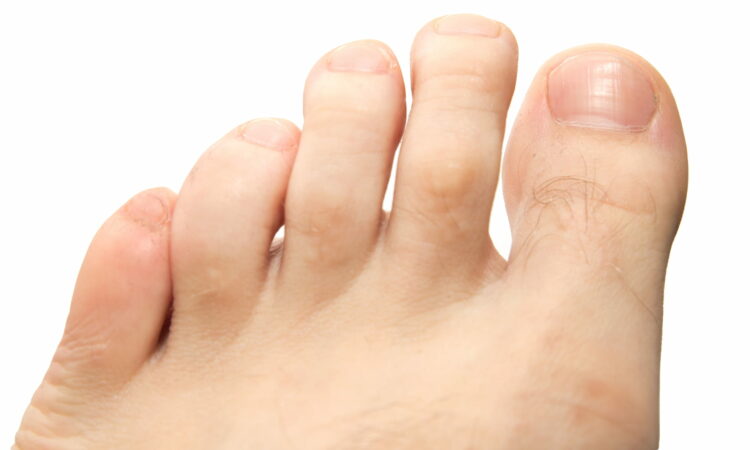
Our toes are one of the least appreciated parts of our bodies.
Fess up. As long as they fit into your shoes, you take your toes for granted. Maybe even more than your belly button.
When you’re in tip-top health, that’s fine.
But your toes also serve as proverbial canaries in a coal mine.
Because they’re the farthest away from your brain and vital organs, maintaining them is the least critical thing your body does. When people are really starving, their bodies rob nutrients and protein from the toes and feet first.
If you’re not in tip-top health, but don’t yet feel the effects of an adverse medical condition, your toes and toenails can clue you something’s wrong.
Condition 1
Your toes are blue, or just plain cold when you’re in an otherwise comfortable temperature.
This could include your feet as well.
Potential Problem 1: Heart disease
When plaque builds up on the insides of your arteries, it slows and blocks the flow of blood.
When plaque breaks up or blocks an artery leading to your heart, that’s a heart attack.
But plaque doesn’t distinguish between the arteries leading to your heart and the rest of your circulatory system. If you’ve got plaque in one artery, you’ve got it everywhere.
Plaque blocking the flow of blood – and its warmth – to your extremities is a sign it could also be blocking the arteries leading to your heart, setting you up for a heart attack.
Potential Problem 2: Raynaud’s syndrome
This is a rheumatic condition where small blood vessels in your fingers or toes spasm. That causes them to turn white or blue in cold temperatures.
Condition 2
You feel numbness, tingling or burning in your toes and feet.
Potential Problem 1: Diabetes
Those feelings indicate you have poor circulation, and possible nerve damage (peripheral neuropathy) – both often caused by diabetes.
Uncontrolled diabetes means your blood sugar is too high. This damages both your nerves and your veins and arteries.
Potential Problem 2: Poor circulation due to other problems
These could include injuries to your feet and toes or simply that you need more exercise.
This is more common in overweight people, but can happen to thin people as well.
These problems are all related: overweight individuals who don’t exercise enough are more at risk of diabetes and all the complications of having chronically high blood sugar levels.
Potential Problem 3: Underactive thyroid gland
Your thyroid gland makes hormones that help control how fast or slowly your body consumes energy. This gland tells every cell in your body how much fat to burn – that is, how much heat to produce.
Low levels of thyroid hormone therefore result in you feeling chilly even in a warm temperature – and your feet feel even colder.
Condition 3
Your toe joints are painful and inflamed.
Potential Problem 1: Rheumatoid Arthritis
This is an autoimmune disorder. Your immune system is attacking parts of your own body.
That can include the joints at the base of the toes.
It erodes the bones of your toes, causing great pain.
Potential Problem 2: Osteoarthritis
This form of arthritis is caused more by age and wear and tear to the joints. When your toes – especially the second and third ones – are bent, that’s called hammer toes.
Potential Problem 3: Psoriatic Arthritis
Patients with this condition see the joints at the end of their toes swell up like “little sausages,” in the words of one doctor.
This usually happens to the third, fourth and fifth toes. Oftentimes these patients also suffer lower back pain.
Potential Problem 4: Gout
Your body normally eliminates uric acid through your kidneys. Sometimes, however, your kidneys can’t keep up – or your body just makes too much. The excess of uric acid then accumulates in your blood, causing intense pain to feet and toes.
Gout used to be known as the disease of kings and the wealthy. That’s because it’s assocated with a diet high in protein and alcohol. Until recently, the vast majority of people couldn’t afford to consume lots of meat and alcohol every day.
We can all dine like kings now – so we can all get the disease of kings.
Getting back on protein-rich foods and alcohol can help control symptoms – and see your doctor.
Condition 4:
Concave, “spoon” nails
Potential Problem: Anemia
Some people are simply born with nails that curl up.
However, if you weren’t born with concave nails and you notice you now have them, you need to investigate.
How large is the indentation? If it could hold a drop of water, you might have anemia. Check it out with your doctor.
Other Potential Problems:
The onset of spoon nails in someone not born with them could also indicate the possibility of various autoimmune disorders or an underactive thyroid gland.
Condition 5:
Clubbed toes (when you weren’t born with them)
Potential Problem: Lung disease
Or heart disease.
Clubbed toes are when the tips of your toes enlarge so the toenails are more rounded at the top and curve downward.
This could be your toes reacting to the condition of low blood oxygen. That could be caused by lung disease reducing how much oxygen your body is absorbing.
Or they could be related to heart and circulatory conditions not supplying your toe cells with the oxygen they need.
Therefore, if you develop clubbed toes, make sure you let your doctor know.
Conclusion
Pay more attention to your feet, toes, and toenails.
If you detect a potential problem, let your doctor know right away.
https://www.youtube.com/watch?v=2qGeR0TX2-I
https://www.youtube.com/watch?v=GIWji99P-DM
https://www.youtube.com/watch?v=GIWji99P-DM&pp=ygUMaGVhbHRoeSB0b2Vz
https://www.youtube.com/watch?v=7D9zxpUES_0
https://www.aarp.org/health/conditions-treatments/info-2023/what-toes-and-toenails-can-say-about-your-health.html







